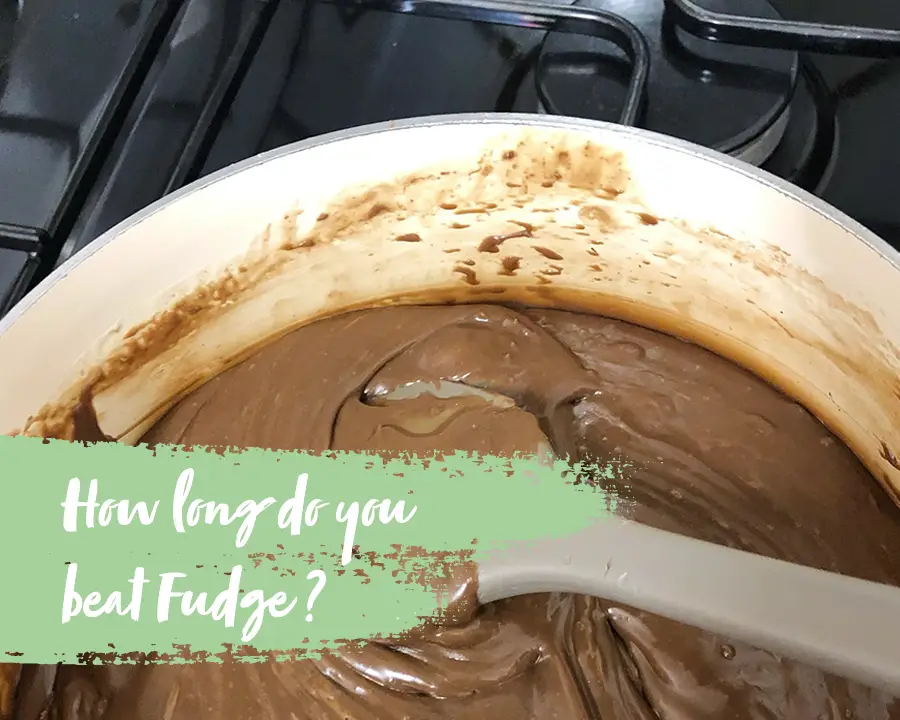“Proper” fudge is quite simply white sugar, brown sugar and cream. You may require some additions for whatever twist you like, be it nuts, maple or vanilla for example.
Other ingredients can be added depending on the recipe you’re working with: icing sugar, maple syrup, corn syrup, evaporated milk, marshmallows, dark chocolate, white chocolate…
But the real secret to successful fudge is not so much in the ingredients but in how you make it.
Texture
What’s the thing you want most in your perfect piece of fudge?
It should stick together well without being too hard and most importantly it has to melt in your mouth when you take a bite. This is the mouth-watering sensation we all crave when buying fudge.
It’s the size of sugar crystals that makes that beautiful creamy, smooth taste explosion. The smaller the crystals, the less they are felt on the tongue and the more the fudge tastes smooth and creamy.
Cooking, and beating for the correct amount of time after cooking is the secret to great fudge.
Cooking
Cooking is an essential part of dissolving the sugar crystals and boiling out any water in the cream. Getting the timing right at this stage has a direct effect on the firmness of the fudge.
The length of this step has a direct impact on the firmness of the fudge. If too much evaporation occurs from boiling it too long, there will not be enough water left in the mixture and it will turn out too hard.
On the other hand, if the cooking time is too short, too much water will remain in the mixture and the fudge will be too soft. The perfect temperature for fudge is between 234 and 237 °F/ 112 and 114 °C.
This is essential for perfect fudge.
Don’t Stir During The Cooking Process
You can cook fudge both on the stove and in the microwave. The benefit of using a microwave is that the mixture will not glue itself to the bottom of the pan during the cooking process.
It’s important that both on the stove and in the microwave, the cream and sugar must be brought to the boil by gently stirring, it is imperative that once it’s boiling you stop stirring for the entirety of the rest of the process.
Sugar crystallization causes a knock-on effect, if a crystal is in the mixture, other sugar parts will gravitate towards one another and stick, creating a grainy fudge and we don’t want that!
How To Avoid Crystallization
When you are cooking your fudge, the sugar crystals tend to stick to the sides of the pan. If you try to combat this by stirring the mixture, the crystals will fall into the mix and stick to one another, making that grainy fudge we don’t want.
To avoid this problem, at the start of the cooking process, brush the sides of the pan with a silicone brush dipped in water.
Let It Cool Before Beating
After the fudge has been cooked, the sugar must crystallize again to create the beautiful fudge you crave!
This stage will determine the size of the sugar crystals, which is a fundamental part of the process. Ideally, the sugar should form small crystals that you can barely feel on your tongue.
In order to accomplish this piece of mastery, let the mix cool for exactly 15 minutes. As it cools it will thicken, so when you beat the mixture, sugar molecules won’t be able to cling on to one another.
Creating small crystals is how the best fudge is made.
Popular opinion states that you should beat the mixture when its temperature is between 109 to 113 °F/ 43 to 45 °C, this usually occurs fifteen minutes after the fudge is removed from heat (in a normal ‘room temperature’ environment).

How Long To Beat The Mixture
After letting the fudge cool down, it’s time for the beating to begin. It is essential to stir constantly with a wooden spoon or a mixer on low speed, until the mixture starts to thicken and its surface starts to look dull, you want it to lose its ‘shiny’ look.
This usually takes between 12 – 15 minutes. If the fudge is still shiny you need to beat for longer.
When the fudge has toughened up but is not completely firm, add the nuts, if desired, and mix until blended. As quickly as possible, scrape the fudge into your desired pan. Smooth the surface with a lightly buttered knife.
Once this is done, set aside the fudge to cool completely, this usually takes a few hours. Once it’s cooled adequately at room temperature, place it in the fridge for another few hours until firm.
In summary
It’s Fudge Time
Fudge is a great thing to learn to cook, it’s fun and creative and tastes amazing when you get it right.
Whether it’s just for you or fun amongst family and friends, having this skill tucked up your sleeve is a great attribute to your culinary skills! It’s no easy feat getting it to all come together correctly.
But when it does… wow, the smooth mouth-watering bliss melting on your tongue, whilst the mixture of flavours explode in your mouth… who wouldn’t want to learn how to achieve this?


